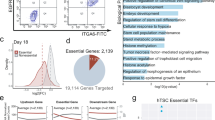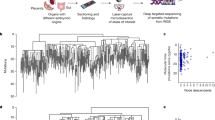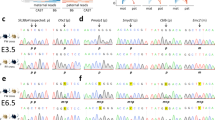Abstract
Placentas can exhibit chromosomal aberrations that are absent from the fetus1. The basis of this genetic segregation, which is known as confined placental mosaicism, remains unknown. Here we investigated the phylogeny of human placental cells as reconstructed from somatic mutations, using whole-genome sequencing of 86 bulk placental samples (with a median weight of 28 mg) and of 106 microdissections of placental tissue. We found that every bulk placental sample represents a clonal expansion that is genetically distinct, and exhibits a genomic landscape akin to that of childhood cancer in terms of mutation burden and mutational imprints. To our knowledge, unlike any other healthy human tissue studied so far, the placental genomes often contained changes in copy number. We reconstructed phylogenetic relationships between tissues from the same pregnancy, which revealed that developmental bottlenecks genetically isolate placental tissues by separating trophectodermal lineages from lineages derived from the inner cell mass. Notably, there were some cases with full segregation—within a few cell divisions of the zygote—of placental lineages and lineages derived from the inner cell mass. Such early embryonic bottlenecks may enable the normalization of zygotic aneuploidy. We observed direct evidence for this in a case of mosaic trisomic rescue. Our findings reveal extensive mutagenesis in placental tissues and suggest that mosaicism is a typical feature of placental development.
This is a preview of subscription content, access via your institution
Access options
Access Nature and 54 other Nature Portfolio journals
Get Nature+, our best-value online-access subscription
$29.99 / 30 days
cancel any time
Subscribe to this journal
Receive 51 print issues and online access
$199.00 per year
only $3.90 per issue
Buy this article
- Purchase on Springer Link
- Instant access to full article PDF
Prices may be subject to local taxes which are calculated during checkout




Similar content being viewed by others
Data availability
DNA sequencing data are deposited in the European Genome-phenome Archive (EGA) with accession code EGAD00001006337. Sample information and data on mutation burdens and signatures can be found in Supplementary Table 1. Further clinical information can be found in Supplementary Tables 2 and 3. Somatic mutations and embryonic mutations (bulk samples) can be found in Supplementary Tables 4 and 6, respectively. Calls of structural variants with associated copy number changes can be found in Supplementary Table 5.
Code availability
Bespoke R scripts used for analysis and visualization in this study are available online at https://github.com/TimCoorens/Placenta.
Change history
28 February 2022
A Correction to this paper has been published: https://doi.org/10.1038/s41586-021-04347-9
References
Kalousek, D. K. & Dill, F. J. Chromosomal mosaicism confined to the placenta in human conceptions. Science 221, 665–667 (1983).
Brosens, I., Pijnenborg, R., Vercruysse, L. & Romero, R. The “Great Obstetrical Syndromes” are associated with disorders of deep placentation. Am. J. Obstet. Gynecol. 204, 193–201 (2011).
Kalousek, D. K. et al. Confirmation of CVS mosaicism in term placentae and high frequency of intrauterine growth retardation association with confined placental mosaicism. Prenat. Diagn. 11, 743–750 (1991).
Xenopoulos, P., Kang, M. & Hadjantonakis, A. K. Cell lineage allocation within the inner cell mass of the mouse blastocyst. Results Probl. Cell Differ. 55, 185–202 (2012).
Bolton, H. et al. Mouse model of chromosome mosaicism reveals lineage-specific depletion of aneuploid cells and normal developmental potential. Nat. Commun. 7, 11165 (2016).
Behjati, S. et al. Genome sequencing of normal cells reveals developmental lineages and mutational processes. Nature 513, 422–425 (2014).
Ju, Y. S. et al. Somatic mutations reveal asymmetric cellular dynamics in the early human embryo. Nature 543, 714–718 (2017).
Coorens, T. H. H. et al. Embryonal precursors of Wilms tumor. Science 366, 1247–1251 (2019).
Alexandrov, L. B. et al. The repertoire of mutational signatures in human cancer. Nature 578, 94–101 (2020).
Gaccioli, F., Lager, S., Sovio, U., Charnock-Jones, D. S. & Smith, G. C. S. The pregnancy outcome prediction (POP) study: investigating the relationship between serial prenatal ultrasonography, biomarkers, placental phenotype and adverse pregnancy outcomes. Placenta 59, S17–S25 (2017).
The ICGC/TCGA Pan-Cancer Analysis of Whole Genomes Consortium. Pan-cancer analysis of whole genomes. Nature 578, 82–93 (2020).
Lee-Six, H. et al. The landscape of somatic mutation in normal colorectal epithelial cells. Nature 574, 532–537 (2019).
Moore, L. et al. The mutational landscape of normal human endometrial epithelium. Nature 580, 640–646 (2020).
Brunner, S. F. et al. Somatic mutations and clonal dynamics in healthy and cirrhotic human liver. Nature 574, 538–542 (2019).
Poetsch, A. R. The genomics of oxidative DNA damage, repair, and resulting mutagenesis. Comput. Struct. Biotechnol. J. 18, 207–219 (2020).
Castellucci, M., Scheper, M., Scheffen, I., Celona, A. & Kaufmann, P. The development of the human placental villous tree. Anat. Embryol. (Berl.) 181, 117–128 (1990).
Knöfler, M. et al. Human placenta and trophoblast development: key molecular mechanisms and model systems. Cell. Mol. Life Sci. 76, 3479–3496 (2019).
Gröbner, S. N. et al. The landscape of genomic alterations across childhood cancers. Nature 555, 321–327 (2018).
Choufani, S., Shuman, C. & Weksberg, R. Molecular findings in Beckwith–Wiedemann syndrome. Am. J. Med. Genet. C Semin. Med. Genet. 163, 131–140 (2013).
Arima, T. et al. Association of IGF2 and H19 imprinting with choriocarcinoma development. Cancer Genet Cytogenet 93, 39–47 (1997).
Martincorena, I. et al. Somatic mutant clones colonize the human esophagus with age. Science 362, 911–917 (2018).
Martincorena, I. et al. High burden and pervasive positive selection of somatic mutations in normal human skin. Science 348, 880–886 (2015).
Kuijk, E. et al. Early divergence of mutational processes in human fetal tissues. Sci. Adv. 5, eaaw1271 (2019).
Jauniaux, E. et al. Onset of maternal arterial blood flow and placental oxidative stress. A possible factor in human early pregnancy failure. Am. J. Pathol. 157, 2111–2122 (2000).
Amor, D. J. et al. Health and developmental outcome of children following prenatal diagnosis of confined placental mosaicism. Prenat. Diagn. 26, 443–448 (2006).
Baffero, G. M. et al. Confined placental mosaicism at chorionic villous sampling: risk factors and pregnancy outcome. Prenat. Diagn. 32, 1102–1108 (2012).
Toutain, J., Goutte-Gattat, D., Horovitz, J. & Saura, R. Confined placental mosaicism revisited: impact on pregnancy characteristics and outcome. PLoS ONE 13, e0195905 (2018).
Grati, F. R. et al. Outcomes in pregnancies with a confined placental mosaicism and implications for prenatal screening using cell-free DNA. Genet. Med. 22, 309–316 (2020).
Henderson, K. G. et al. Distribution of mosaicism in human placentae. Hum. Genet. 97, 650–654 (1996).
Peñaherrera, M. S. et al. Patterns of placental development evaluated by X chromosome inactivation profiling provide a basis to evaluate the origin of epigenetic variation. Hum. Reprod. 27, 1745–1753 (2012).
Moreira de Mello, J. C. et al. Random X inactivation and extensive mosaicism in human placenta revealed by analysis of allele-specific gene expression along the X chromosome. PLoS ONE 5, e10947 (2010).
Sovio, U., White, I. R., Dacey, A., Pasupathy, D. & Smith, G. C. S. Screening for fetal growth restriction with universal third trimester ultrasonography in nulliparous women in the Pregnancy Outcome Prediction (POP) study: a prospective cohort study. Lancet 386, 2089–2097 (2015).
Li, H. & Durbin, R. Fast and accurate short read alignment with Burrows–Wheeler transform. Bioinformatics 25, 1754–1760 (2009).
Jones, D. et al. cgpCaVEManWrapper: simple execution of CaVEMan in order to detect somatic single nucleotide variants in NGS data. Curr. Protoc. Bioinformatics 56, 15.10.1–15.10.18 (2016).
Ye, K., Schulz, M. H., Long, Q., Apweiler, R. & Ning, Z. Pindel: a pattern growth approach to detect break points of large deletions and medium sized insertions from paired-end short reads. Bioinformatics 25, 2865–2871 (2009).
Van Loo, P. et al. Allele-specific copy number analysis of tumors. Proc. Natl Acad. Sci. USA 107, 16910–16915 (2010).
Buels, R. et al. JBrowse: a dynamic web platform for genome visualization and analysis. Genome Biol. 17, 66 (2016).
Coorens, T. H. H. et al. Lineage-independent tumors in bilateral neuroblastoma. N. Engl. J. Med. 383, 1860–1865 (2020).
Olafsson, S. et al. Somatic evolution in non-neoplastic IBD-affected colon. Cell 182, 672–684.e11 (2020).
Robinson, P. S. et al. Elevated somatic mutation burdens in normal human cells due to defective DNA polymerases. Preprint at https://doi.org/10.1101/2020.06.23.167668 (2020).
Hoang, D. T. et al. MPBoot: fast phylogenetic maximum parsimony tree inference and bootstrap approximation. BMC Evol. Biol. 18, 11 (2018).
Rosenthal, R., McGranahan, N., Herrero, J., Taylor, B. S. & Swanton, C. DeconstructSigs: delineating mutational processes in single tumors distinguishes DNA repair deficiencies and patterns of carcinoma evolution. Genome Biol. 17, 31 (2016).
Acknowledgements
We thank M. Zernicka-Goetz, M. Stratton and I. Martincorena for insightful discussions. This experiment was primarily funded by Wellcome (core funding to the Wellcome Sanger Institute, and personal fellowships to T.H.H.C., T.R.W.O. and S.B.). All research at Great Ormond Street Hospital NHS Foundation Trust and UCL Great Ormond Street Institute of Child Health is made possible by the NIHR Great Ormond Street Hospital Biomedical Research Centre. The Pregnancy Outcome Prediction study was supported by the National Institute for Health Research (NIHR) Cambridge Biomedical Research Centre (Women’s Health theme). The views expressed are those of the authors and not necessarily those of the NHS, the NIHR or the Department of Health and Social Care.
Author information
Authors and Affiliations
Contributions
S.B. designed the experiment. T.H.H.C. performed phylogenetic analyses. T.H.H.C. and T.R.W.O. analysed somatic mutations. T.R.W.O. performed microdissections. R.S., U.S., E.C., R.V.-T., M.H., M.D.Y. and R.R. contributed to experiments or analyses. N.S. provided histopathological expertise. P.J.C. contributed to discussions. S.B., T.H.H.C. and T.R.W.O. wrote the manuscript, aided by D.S.C.-J. and G.C.S.S. D.S.C.-J., G.C.S.S. and S.B. co-directed this study.
Corresponding authors
Ethics declarations
Competing interests
The authors declare no competing interests.
Additional information
Peer review information Nature thanks Daniel Ariad, Marshall Horwitz, Rajiv McCoy and the other, anonymous, reviewer(s) for their contribution to the peer review of this work. Peer reviewer reports are available.
Publisher’s note Springer Nature remains neutral with regard to jurisdictional claims in published maps and institutional affiliations.
Extended data figures and tables
Extended Data Fig. 1 Differences in substitutions between clinical groups.
a, Analysis per clinical group of the substitution burden of each bulk placental sample, adjusted for coverage and median VAF (n = 84, samples from trisomic rescue case not included). The centre values represent the cohort median whilst the lines denote the interquartile range. The difference in substitution burden between the clinical groups is not significant (Kruskal–Wallis rank-sum test, P = 0.7438). b, Mutational signature profiles of each placenta by their clinical group (n = 36, placenta from trisomic rescue case not included). Each column represents one placenta (signature extraction performed across all unique substitutions per placenta in view of their low individual mutation burdens). Clinical groups are defined in Supplementary Tables 2, 3.
Extended Data Fig. 2 Unique variants in placental biopsies.
Proportion of variants that are unique to each bulk placental sample (blue), and are therefore absent from matched umbilical cord as well as any other bulk placental sample taken from the same case.
Extended Data Fig. 3 Asymmetry across trophectoderm and umbilical cord.
Heat maps of VAFs of early embryonic mutations, with the two earliest lineages contributing both to the placenta and umbilical cord. Putative earliest mutations are highlighted in red. P, placenta; M, maternal.
Extended Data Fig. 4 Unexplained placental lineages.
Heat maps of VAFs of early embryonic mutations, with the two earliest lineages contributing to the umbilical cord. Putative earliest mutations are highlighted in red. An asterisk indicates that the placental lineage is not fully explained by the umbilical cord (Methods).
Extended Data Fig. 5 Full segregation of placental and umbilical cord lineages.
Heat maps of VAFs of early embryonic mutations, with the umbilical cord being derived from one clonal lineage. In all cases, one or more placental lineages do not share any genetic ancestry with the umbilical cord and are largely unexplained (indicated by an asterisk) (Methods).
Extended Data Fig. 6 Substitution burden per individual trophoblast cluster.
Adjusted for coverage and median VAF.
Extended Data Fig. 7 Indels versus substitutions.
Indel burden versus substitution burden per trophoblast cluster. Both are corrected for median VAF and coverage.
Extended Data Fig. 8 Effects of mutations.
a, b, Overview of functional consequences of the unique SNVs (a) and indels (b) seen in the placental biopsies and trophoblast clusters.
Extended Data Fig. 9 Sensitivity of variant calling.
a, Histogram of the estimated sensitivity for SNV calling in microdissected trophoblast clusters and bulk placenta samples. b, The observed sensitivity of germline variants across placental samples plotted against the coverage of the sample. The red dashed line indicates the predicted sensitivity using the correction that we applied to our cohort.
Extended Data Fig. 10 Signature extraction and deconvolution.
a–c, Signature extraction by hierarchical Dirichlet process yielded a noise component (a) and one genuine mutational signature (b), which we convoluted and reconstructed using three reference mutational signatures (SBS1, SBS5 and SBS18) (c).
Supplementary information
Supplementary Results
Exclusion of maternal contamination. Boxplots of B-allele frequency (BAF) of rare SNPs called in mother, but absent from umbilical cord, as an indicator of possible maternal contamination across placental samples.
Supplementary Tables
This file contains Supplementary Tables 1-6.
Rights and permissions
About this article
Cite this article
Coorens, T.H.H., Oliver, T.R.W., Sanghvi, R. et al. Inherent mosaicism and extensive mutation of human placentas. Nature 592, 80–85 (2021). https://doi.org/10.1038/s41586-021-03345-1
Received:
Accepted:
Published:
Issue Date:
DOI: https://doi.org/10.1038/s41586-021-03345-1
This article is cited by
-
Genetic variation across and within individuals
Nature Reviews Genetics (2024)
-
Aneuploidy and complex genomic rearrangements in cancer evolution
Nature Cancer (2024)
-
Reconstructing phylogenetic trees from genome-wide somatic mutations in clonal samples
Nature Protocols (2024)
-
Human embryonic genetic mosaicism and its effects on development and disease
Nature Reviews Genetics (2024)
-
Mechanism of chromosomal mosaicism in preimplantation embryos and its effect on embryo development
Journal of Assisted Reproduction and Genetics (2024)
Comments
By submitting a comment you agree to abide by our Terms and Community Guidelines. If you find something abusive or that does not comply with our terms or guidelines please flag it as inappropriate.



